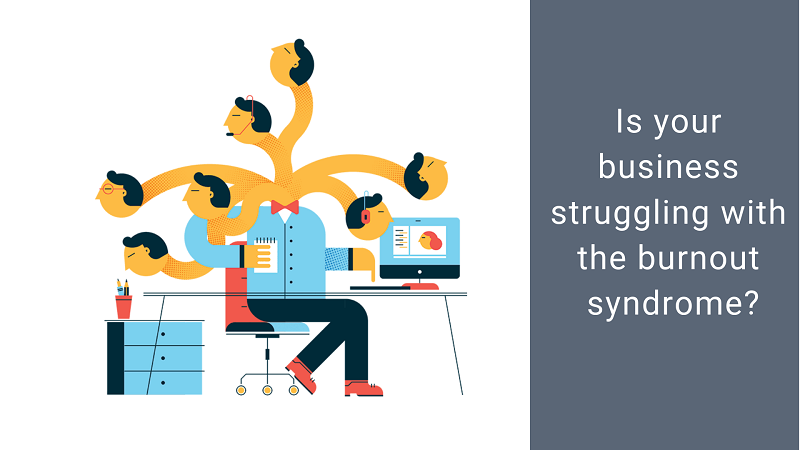Physical and psychological exhaustion is common in the work environment. In this post, discover how you can fight Burnout syndrome!
Did you know that an adverse work environment can cause physical and mental problems, a harmful consumption of substances and alcohol, absenteeism and loss of productivity, according to the WHO?
Despite being increasingly common problems, they are still treated as taboos in companies.
This is because they are easily associated with madness and even “foolishness” – something that does not match reality. Therefore, it is increasingly common to see professionals with Burnout syndrome.
Recently, the World Health Organization (WHO) included the syndrome within the list of the International Classification of Diseases with the code QD85 within the chapter of problems associated with employment and unemployment.
In this post, we will discuss the impact that the disease has had on the current world, how it can affect work.
We will also talk about the main symptoms so you can identify and fight it. Continue reading and take a look!
What does Burnout Syndrome mean?
The Burnout Syndrome or the syndrome of professional exhaustion is considered a psychic disorder defined in 1974 by the German psychologist Hebert J. Freudenberger.
It is associated with a state of emotional stress and chronic stress, both caused by the working conditions offered to the worker. This covers the physical, emotional and psychological aspects.
It is important to clarify an important point, the origin of the term. Burnout is a word consisting of two words of English origin: burn (burn) and out (entirely).
This differentiates it from stress, with which it is commonly confused. The latter may appear in different contexts, while the former is motivated by exhaustion in relation to the activity or the work environment.
How can professional exhaustion affect you?
The costs of professional exhaustion are high for both organizations and their collaborators.
People who have such syndrome tend to have a drastic fall in productivity, lose opportunities, are more prone to errors, delay the delivery of projects, among others.
On the other hand, the business is also affected. You can begin to suffer from work accidents and the increase of expenses with the worker’s health, which starts to present problems with and due to bad management (depending on the person who is with the syndrome) and with the high turnover of employees, etc.
The consequences of all this are the loss of customers, the health of employees and the decrease of organizational competitiveness.
What are the main symptoms of Burnout syndrome?
The identification of exhaustion may begin with the smallest warning signs. However, over time, they become increasingly large, and that is when the Burnout Syndrome begins to hatch.
Below I will show you some of the main symptoms:
Accelerated fall in productivity
Imagine that nothing else is as before. Productivity dropped a lot and you can no longer perform work during work hours.
In turn, this generates an accumulation of tasks, which generates more and more anxiety and stress due to not being able to achieve the desired success.
The drop in production is one of the first symptoms of burnout and, generally, it is followed by low quality in the execution of tasks that were previously easily performed.
Feeling of impotence
And speaking in stress, the accumulation of tasks and responsibilities and the constant pressures associated with not taking advantage of the collaborators’ competences cause a feeling of helplessness.
Then, the lack of expectations contributes to the work environment becoming a burden for some people.
On several occasions, this generates physical and emotional collapse and fall in self-confidence, and the collaborator feels that his work does not make more sense.
Somatization
Headaches, lack of appetite, tachycardia, low immunity and lack of air are just some of the problems caused by somatization, which is the physical manifestation of mental disorders.
When you perceive that the presence of certain diseases is frequent, for no apparent reason, the collaborator must observe the work environment. The manifestation of this symptom depends on the level of involvement with it.
While some people manage to manage the situation well, others do not. However, it should be noted that this does not mean lack of will power.
Change of humor
Has it ever occurred to you to ask anyone a question at work and she suddenly gets stressed or gives you a “moody” answer?
You can see that in most cases, this reaction is linked to exhaustion and the demands of work.
If the symptom is with you and anything irritates you, leaving you sensitive or sad, try to identify if the problem at work is overcoming barriers and interfering in socialization with colleagues.
How to treat the problem?
The World Health Organization defends a treatment based on measures to improve the work environment, the search for help in the hands of professionals and a special one that we want to highlight: offering employees professional development programs and rewards the contribution of the staff.
However, the person who suffers with burnout can help with some simple attitudes applied in everyday life.
Disconnect from obligations
Practice the disconnection of social networks and also of your own work when you are away. The excess of information to which we are exposed provides more stress and immediacy for our daily life, aggravating psychological exhaustion.
Today, there is already a denomination for the excesses of technologies and social networks in our day to day: FOMO (Fear of Missing Out or fear of losing something).
This problem is associated with being connected 24 hours a day, which generates anguish and bad mood and contributes to exhaustion.
Take advantage of leisure time
Have moments for leisure, practice physical activities and be close to who makes you feel good. Physical exercise, for example, is an excellent remedy to combat stress, without counting the benefits it brings to health.
Therefore, take advantage of rest moments. Even if you are not doing anything, it is possible to rest. This will help you to have the strength to fight the symptoms of burnout and avoid the accumulation of stress and anxiety in your routine.
Seek help from your coordinators
Is work wearing you out in such a way that you do not feel like going any further? A good way to deal with this issue is to talk to your superiors.
Express the entire situation, talks about solutions (such as reducing the burden of obligations) and, if possible, request a permit or advance payment for vacations.
Transparency is crucial to win the confidence of superiors and also to alert them to the organization of the work environment.
In several situations, the problem is in the format of the business and in the pressures exerted on the employees. Thus, the conversation can be fundamental to avoid the situation and prevent other people from suffering from the problem.
Why is mental health so important in the work environment?
The human being does not work like a machine. He has emotions, he is tired and he likes to feel valued. Therefore, the Burnout Syndrome serves as an alert for organizations to treat mental health with greater care in the work environment.
If the mind is tired, it loses its efficiency and performance. Therefore, it does not work anymore. The results will be lower than expected. This causes frustration to increase and important decisions are postponed.
There is an interesting phrase by the writer François de la Rochefoucauld who portrays the question well:
“When we cannot find tranquility within ourselves, it is useless to seek it elsewhere.”
At the slightest sign of Burnout syndrome, look for proper treatment and practices to help you.
We hope you enjoyed our post!






